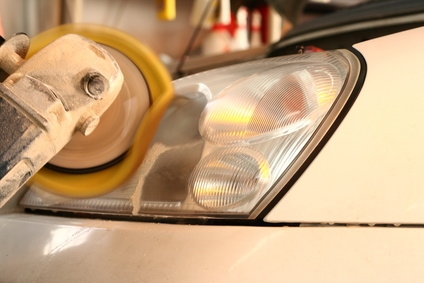
Paint overspray is usually caused during the refinishing stage of an accident repair process. Small gaps in masking tape or paper can allow paint vapor to pass underneath onto unprotected panels while the vehicle is being painted. Once the baking process is complete, the overspray can be difficult to remove. Various methods should be applied on different parts of the vehicle in order to remove overspray completely.
Apply spray glass cleaner to all areas affected by overspray. A generous supply is necessary because the glass cleaner must act as a lubricant on the window.
Hold a new double-edged blade at a 90-degree angle against the wet glass. It is better to hold it as close to the cutting edge as possible to maintain control of the blade.
Move the blade in short, back-and-forth movements without applying excessive pressure. Let the blade do the work and add more glass cleaner as necessary. The blade will remove paint overspray easily without scratching the windows.
Apply a final application of glass cleaner and dry all windows with a piece of dry workshop paper.
Fill a clean spray bottle with warm water and a small amount of liquid detergent. The detergent must be a suitable automotive product or else bleaching to paintwork could occur.
Working one panel at a time, spray copious amounts of the detergent mix onto the surface of the car.
Hold a clay bar firmly between the fingers and place it onto the panel of the car. Using the solution from the spray bottle as a lubricant, lightly work the clay bar in small circles to remove overspray. Ensure the panel of the vehicle stays wet at all times to help prevent scratching.
Once the overspray is removed, dry off residual water from the panel with a clean, synthetic leather. Look for any additional signs of overspray and repeat as necessary before moving on to the next panel.
Stubborn overspray can be removed with a piece of P2000 grit wet-and-dry paper. Where the paintwork is left flat, bring it back to a shine using a polishing mop and a small amount of cutting compound.
Apply a very small amount of solvent-based panel wipe to a piece of fabric cloth. Working on a single component at a time, lightly wipe over all metal trim to remove overspray.
Solvent-based panel can also be used on most plastics, although testing should take place on a small and inconspicuous area beforehand to ensure staining does not occur.
If metal trim has stubborn overspray marks, dip a piece of wire wool into some solvent-based panel wipe and rub gently. Do not use this method on chrome.
Overspray on headlights and tail lights can be removed by wiping a small amount of cutting compound over them and buffing them with a polishing mop.